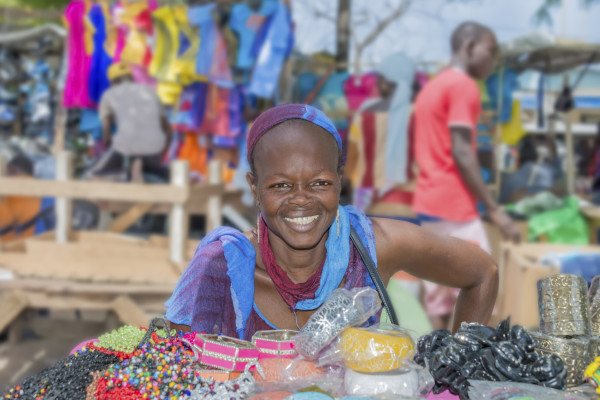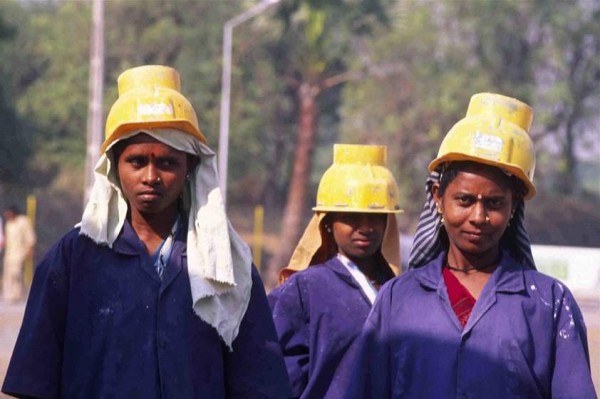Can the New Urban Agenda fundamentally transform gender relations?
Caroline Moser
The Habitat III negotiations offer a unique opportunity to recognize the centrality of gender in urban policy and practice. But these will not be successful unless fundamental changes are incorporated.

In the build-up to Habitat III, this year’s major summit aimed at setting global urbanization strategy, the refrain on everyone’s lips is about “transformation”.
The Habitat III background agenda, for instance, identifies “transforming cities” as an objective. Likewise, the Urban Thinkers Campuses — more than two-dozen global events, spearheaded by the World Urban Campaign, aimed at formulating stakeholder input to Habitat III — “believe that urbanization … can lead to positive urban transformations”. Key technical papers that inform this process provide “transformative actions”. There is even an NGO called Women Transforming Cities.
Yet there is no shared understanding of the term “transformation”. In addition, if such a term gets too popularized, it is likely to become meaningless and without a consistent message. This is particularly important in guaranteeing that the New Urban Agenda provides a pathway — a strategic route — toward “gender transformation”. The New Urban Agenda is the 20-year strategy around sustainable urbanization that will come out of Habitat III, which takes place in October in Ecuador’s capital, Quito.
In this commentary, transformation is defined as an inherently political act. Closely associated with structural change in gender power relations, it emphasizes collective action. In contrast, the more commonly used term “empowerment” describes how individual women seek to bolster themselves through individual agency in order to increase their bargaining power in public and private.
Why is this important? More than 20 years after the 1995 Beijing Platform for Action, city governments and civil society have “mainstreamed” gender, defined as integrating the concerns of both women and men into urban policies and projects, as well as specific initiatives to empower women. Yet broad inequalities remain. The New Urban Agenda thus provides a unique opportunity to incorporate the centrality of gender — but this will not be successful unless fundamental changes are included.
As Eduardo Moreno, UN-Habitat’s director of research, states, this requires the “programmatic mainstreaming of gender”, with the ultimate goal of achieving both gender equality and women’s empowerment. However, the challenge is to push the agenda much further than ever before.
This means going beyond a focus on women’s “vulnerability” and exclusion, past the identification of women’s practical “basic needs” in urban planning or even the strategic empowerment of individual women. Instead, this means moving toward collective action capable of challenging fundamental inequalities.
Only if the New Urban Agenda effectively identifies pathways that challenge the wider structural power dynamics that perpetuate gender inequality can it successfully promote more equitable, just cities. Otherwise, as UN-Women’s Anne-Marie Goetz and Joanne Sandler have said, gender mainstreaming, yet again, will be no more than a “pathetic illusion of transformation”.
Opportunity of assets
Asset accumulation is increasingly recognized as an important route not only to gender empowerment but also structural transformation. But changes in persistent gender-based inequalities in access to financial, physical, productive, human and social capital occur within contexts of broader driving forces at both the macro level (economic globalization, demographic transition, climate change and disasters) and micro, city level (urban spatial agglomeration, political change, and violence and insecurity).
“The challenge is to push the agenda much further than ever before. This means going beyond a focus on women’s ‘vulnerability’ and exclusion, past the identification of women’s practical ‘basic needs’ in urban planning or even the strategic empowerment of individual women.”

Barriers also include cultural norms affecting gendered divisions of labour and female mobility, affecting earnings, rights to public spaces and participation in urban life. In addition, city-level institutions such as the municipality and urban-planning department can effectively prevent or promote gender-sensitive interventions.
Nonetheless, women, by deciding on strategies around the accumulation of assets, can achieve notable outcomes. Accumulated assets may reduce poverty and increase equality, potentially empowering individual women; eventually, this can challenge power relations.
An essential institutional pre-condition in this is often community social capital, linked to collective action. Women in membership or community-based organizations play critical roles as both rank-and-file members and leaders, with crucial support from advocacy NGOs at the local and international levels.
Still, it is important to recognize that such transformations are not straightforward. Reality is far more complex, particularly when it involves negotiation and struggle around power relations. As the following examples illustrate, these tend to involve long-term, complicated processes.
Securing land tenure for urban women: The Ponte do Maduro master plan in Recife, Brazil: Tenure rights to land as a physical asset make up the highest priority for urban households. Yet gender-based inequalities, often reinforced by culturally determined inheritance laws, mean that gender-sensitive titling programmes are not widespread.
A remarkable exception is the achievement of women’s tenure rights in the master plan for regularizing public land in Recife, Brazil. With municipalities required to prepare plans with local resident participation, Espaço Feminista, an NGO supported by the Huairou Commission (a global network of women’s groups), led a 10-year struggle to ensure that women’s rights were integrated into the regularization process.
The group volunteered to coordinate a pilot project in Ponte do Maduro, a 50-hectare settlement with 10,000 low-income families. It then used what are known as gender evaluation criteria to monitor, evaluate and create accountability around this process and to empower local women to become leaders. Of 5,700 titles now issued, 90 percent are in women’s names, of which 37 percent head their households.
Bringing voice and visibility to women in informal employment: The Asóciacion de Recicladores de Bogotá in Bogotá, Colombia: The vast majority of women in cities accumulate financial capital assets through informal economic activities. Yet urban legal, regulatory and planning environments stigmatize informal work as unproductive, with policies that often erode women’s livelihoods.
The Asóciacion de Recicladores de Bogotá (ARB), a waste pickers’ cooperative founded in the Colombian capital in 1990, helps members accumulate individual financial and human capital assets as well as social capital formed through a collective. ARB is supported by WIEGO, a global network of informal workers’ associations.
ARB’s transformative strategy started with capacity-building, challenging waste pickers’ self-perceptions and emphasizing their professional identity as environmentalists. Then the recyclers began a lengthy, ultimately successful mediation process with city authorities using marches, demonstrations and legal strategies to prevent multinational waste companies and politicians from banning informal recycling.
From land and housing loans to incremental upgrading: The Zimbabwe Homeless People’s Federation: For women the ownership of safe, secure housing is another priority asset, whether attained through top-down housing programmes or bottom-up contestation with local authorities. The Zimbabwe Homeless People’s Federation — together with their support NGO, Dialogue on Shelter — has been involved in the long-term process of acquiring such assets since the late 1990s.
As a member of Slum/Shack Dwellers International (SDI), the federation began by organizing women into small saving groups to collectively strengthen their financial assets. Today there are 1,300 such groups with 53,000 household members in 53 urban centres in Zimbabwe. Men are not excluded, but 80 percent are female members.
The federation then collectively negotiated with local government authorities in Zimbabwean cities to secure land to develop and upgrade housing. It first prioritized previously undeveloped sites, but the benefits accrued to better-off members. While individually empowering, this was not collectively transformative and left disadvantaged the lowest-income households, many headed by women.
Consequently, in cities such as Harare, Kariba and Bulawayo, the emphasis shifted to negotiations with local government authorities to upgrade existing low-income settlements, thereby reaching a much larger number. Over 12,000 families have now secured tenure rights, while since 2009 the federation has saved over USD 1 million and leveraged an additional USD 10 million.
Formal, informal contributions
As we move closer to Habitat III, initiatives to contribute to the New Urban Agenda are intensifying through both formal “insider” meetings led by the Habitat III Secretariat and more informal “outsider” events. Is a transformative gender agenda achieved through its mainstreaming into the different stages preceding the New Urban Agenda, or is it through the numbers of women involved in this process? These two issues must not be conflated, but they can be mutually reinforcing.
“Only if the New Urban Agenda effectively identifies pathways that challenge the wider structural power dynamics that perpetuate gender inequality can it successfully promote more equitable, just cities.”
Contributions to Habitat III by formal initiatives: Two senior professional women head the New York-based Habitat III Bureau: Maryse Gautier of France and María Duarte from the conference host Ecuador.
Equally significant, just under half (45%) of the members of the Habitat III expert “policy units” are women. This appears to have contributed to the incorporation of language on gender equality and women’s needs into the policy papers that each of these units released in February.

But how gender-transformative are the actions associated with these papers? The broadness of the range reflects the fact that gender issues fit more comfortably within “soft” social agendas rather than “hard” economic and physical planning design. Here are a few key trends in this regard:
A few of the policy documents, particularly Paper 1 on the right to the city, include transformative agendas, for instance calling for “a city of gender equality which adopts all necessary measures to combat discrimination”.
Some of the documents, such as Papers 3, 5 and 6, recognize women as actors involved in participatory processes of change, such as participatory budgeting.
Others, such as Papers 2 and 7, still primarily include women as a vulnerable category in need of welfare, along with other marginalized and excluded groups.
Finally, some of the documents, such as Papers 4, 8 and 9, prefer gender-neutral language such as “members of society”, “humans” or “people”.
Contributions to Habitat III by informal initiatives: Civil-society advocacy and activism has played a critical role both in setting the agenda and monitoring the insider process during the run-up to Habitat III. Examples include a meeting that the Huairou Commission hosted in September, called “Engendering the New Urban Agenda”.
During the last Habitat conference — Habitat II, held in 1996 in Istanbul — the mainstreaming of gender had not yet taken place. As a result, as the New School’s Michael Cohen has said, “women’s groups talked to women”.
Yet this time around, the Urban Thinkers Campuses have been able to turn this trend around. This includes events held on urban development (organized by the Habitat International Coalition), housing (Habitat for Humanity and SDI) and the informal economy (WIEGO), as well as the gender-focused events (Huairou Commission).
A final example is provided by the Urban Knowledge Series, annual lectures organized through UN-Habitat’s partnership with global universities now in its third year. Series 1 and 2 saw an impressive balance between female and male lecturers (46/54%). However, a review of lectures to date highlights that challenges remain in the presentation of gender-transformative agendas.
For instance, the majority of lecturers have referred simply to “people” or “poor people” rather than specifically to women or men. One of the lecturers, Ana Falú from the National University of Cordoba, was given a pointed “women’s mandate” but focused on women’s practical rather than strategic needs in urban planning. In the series, SDI members Sheila Patel and Jane Weiru have gone the furthest in identifying women as actors in community surveys and advocacy work challenging local government and the private sector.
Catalysts
Ultimately, Habitat III may have more success in focusing on transformative actions that change social relations in cities in general but that do not challenge unequal gender relations — though they may empower women individually through asset accumulation.
Paradoxically, however, pathways that transform cities into more equitable, just spaces simultaneously may become critical catalysts to create transformation in gender relations. Including women as players in the decision-making processes of Habitat III cannot guarantee transformative change, but doing so can lay important foundations.
This article was originally published in Cityscope.